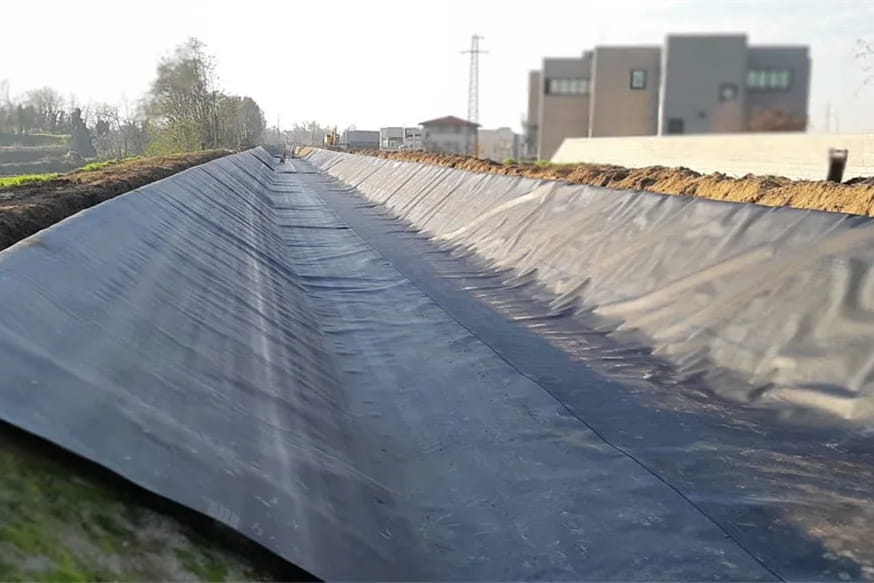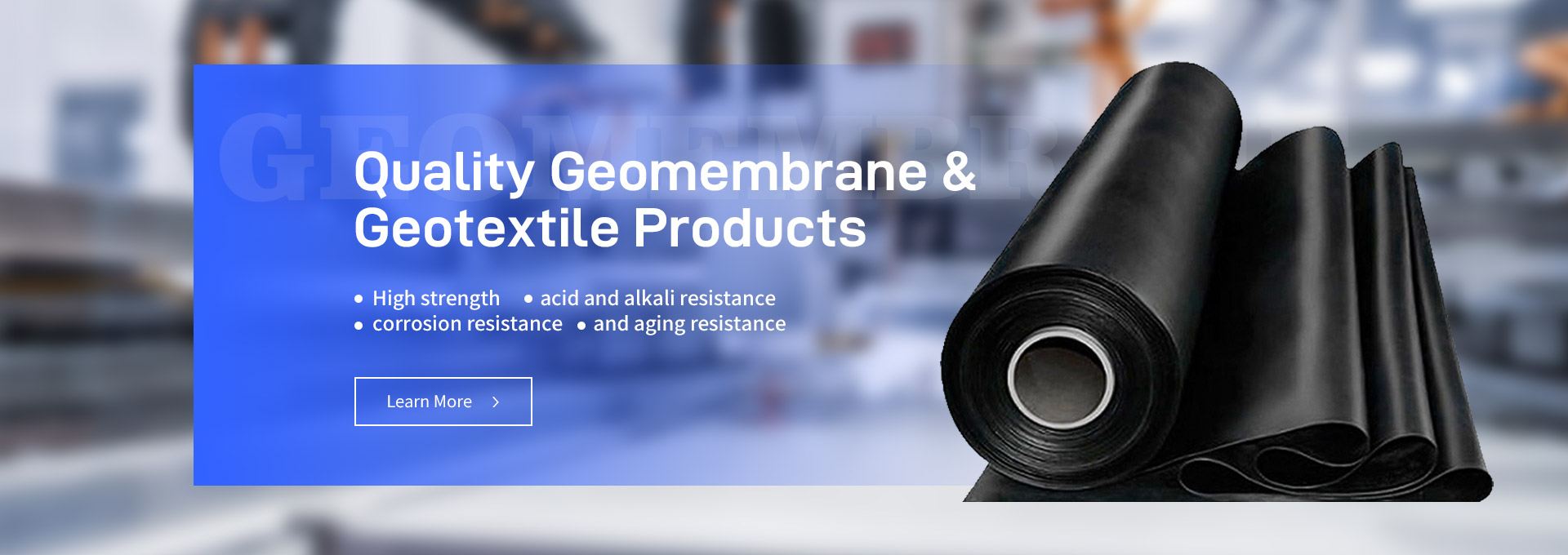Geomembrane is a versatile material widely used in civil engineering, containment systems, and environmental protection projects. It’s commonly applied in areas like landfills, water storage pond geomembrane setups, channels, and dams. Evaluating the tensile strength and durability of geomembrane is crucial, as these factors determine its effectiveness and lifespan in real-world applications. Here, we’ll guide you through the essential metrics and testing methods to help you understand how to assess the quality of geomembrane and select the right product for your needs.

1. Tensile Strength of Geomembrane: The Key to Structural Stability
Tensile strength refers to a material's ability to withstand breaking under tension. For geomembrane, tensile strength is a primary factor in its capacity to support loads and resist deformation. Different projects require various tensile strengths, and understanding this metric is crucial for selecting materials that fit specific engineering requirements.
Understanding Tensile Strength Basics
Tensile strength measures the maximum stress a material can bear when stretched. For pond liner geomembrane, high tensile strength means it can better resist ground settlement, groundwater pressure, and other external forces without tearing.
Testing Methods for Geomembrane’s Tensile Strength
Testing geomembrane tensile strength typically involves a tensile testing machine with the following steps:
Sample Preparation: Cut a uniform strip from the geomembrane (usually 100mm wide) to ensure sample consistency.
Tensile Test: Place the sample in the testing machine, gradually increasing the load until the sample breaks.
Data Recording: Note the maximum load at the point of rupture to calculate tensile strength.
Common Standards for Tensile Strength
Geomembrane tensile strength tests follow specific standards, such as ASTM D6693 and GB/T 17643. Depending on the project requirements, select a standard that ensures the pond liner can handle the loads and stresses it will face.
2. Durability of Geomembrane: Ensuring Long-Term Performance
Beyond tensile strength, durability is another critical factor for geomembrane. Over time, geomembrane is exposed to sunlight, chemicals, and microorganisms, which can degrade its performance. Durable geomembrane will maintain stability in harsh environments, ensuring project integrity.
Factors Influencing Durability
Several factors impact geomembrane durability:
UV Resistance: Geomembrane used outdoors must have high UV resistance to prevent brittleness and aging.
Chemical Stability: In landfills and industrial ponds, geomembrane might come into contact with acids, bases, and oils, so it needs excellent chemical resistance.
Microbial Resistance: Geomembrane exposed to soil or water can face microbial attacks, so microbial resistance prevents degradation.
Testing Methods for Durability
Laboratories perform accelerated aging tests to assess geomembrane durability. Common tests include:
UV Aging Test: Expose the geomembrane sample to simulated UV light to gauge performance over different periods.
Chemical Immersion Test: Immerse samples in acidic or basic solutions, measuring physical property changes to determine chemical resistance.
Microbial Resistance Test: Place samples in controlled microbial environments to check resistance.
Geomembrane Durability Standards
For durability assessments, international standards such as ASTM G154 and GB/T 17643 provide detailed methods. These standards help ensure water storage pond geomembrane and other types remain stable under challenging conditions.
3. How Tensile Strength and Durability Affect Geomembrane Applications
The tensile strength and durability of geomembrane directly influence its suitability for different projects. For instance, landfill geomembranes need both high tensile strength to withstand load pressures and high chemical resistance to resist leachate corrosion. In water storage pond geomembrane applications, resistance to water and UV exposure are top priorities.
Landfills
Landfills require geomembranes that can handle heavy loads and resist leachate corrosion. High tensile strength and chemical durability are essential, and thicker, stronger pond liner geomembrane is often recommended to avoid tearing.
Water Containment Projects
In applications like canals, ponds, and water storage pond geomembrane systems, tensile strength, water resistance, and UV stability are essential. Outdoor projects especially need UV-resistant geomembrane to prevent aging.
Building Foundations
Geomembrane in building foundations is primarily used as a waterproof layer, so water resistance and durability against underground pressures are critical.
4. Choosing the Right Geomembrane
After evaluating the tensile strength and durability, how do you choose the right geomembrane for your project? Here are some tips to help you make the best choice.
Understand Project Requirements
Defining project-specific needs is essential when selecting geomembrane. If your project requires high chemical resistance, choose geomembrane with superior chemical stability. For projects exposed to strong sunlight, prioritize UV-resistant materials.
Select Based on Standards
The market offers various geomembrane options, each with different properties and qualities. Choose products that meet international or industry standards like ASTM or GB. Trusted geomembrane manufacturers often provide certified products with performance reports.
Pay Attention to Material Quality
High-quality geomembrane products tend to perform better in tensile strength and durability tests. Materials like HDPE (High-Density Polyethylene) or LDPE (Low-Density Polyethylene) have proven strength and stability, making them suitable for challenging environments.
5. Maintenance and Care of Geomembrane
Proper maintenance can extend the lifespan of geomembrane in any application. Here are some common maintenance tips for ensuring long-lasting performance.
Minimize Prolonged Exposure
While certain geomembrane types have UV resistance, prolonged exposure to intense sunlight can still impact performance. For outdoor projects, consider using protective layers over the geomembrane to delay aging.
Regular Inspections
Perform regular inspections to check for cracks, discoloration, or signs of wear. In applications like landfills or chemical ponds, inspect more frequently as these environments increase the risk of degradation.
Cleaning and Care
While geomembrane doesn’t need frequent cleaning, some environments may lead to grime buildup, which can affect functionality. Use water or mild cleaners to wash the surface when needed, ensuring it stays in optimal condition.
Conclusion
Geomembrane plays a vital role in modern engineering, and tensile strength and durability are key indicators of its quality. By understanding the testing methods, durability standards, and requirements across different applications, you’ll be better equipped to select geomembrane that suits your project.
When purchasing geomembrane, partnering with reliable geomembrane manufacturers and choosing products that meet industry standards will ensure the best results. We hope this guide helps you understand geomembrane properties better so you can find the ideal product that guarantees long-lasting project stability.

